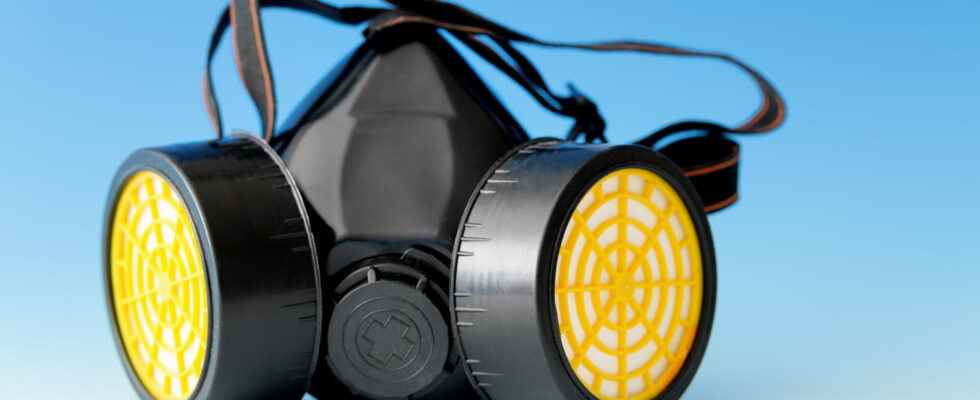The anti-gas mask allows its wearer to breathe safely in an unstable environment. The filters absorb harmful particles and protect the mouth, nose and eyes. What is a nuclear gas mask? Bacteriological? How to put it? What is the principle of a gas mask? His price ? The answers.
Definition: what is a gas mask?
The phrase “gas mask” is a common mistake. Indeed a “gas mask” is used to breathe gas (during anesthesia for example) while the “gas mask“is used for protect yourself from the effects of gases (sulphur dioxide, cyanide, radioactive iodine and particles, nitrogen oxides, etc.). It is a respiratory protection mask against ambient gases which allows its wearer to breathe safely in an unstable environment. It is generally consisting of a mask and a filter. It is an air-purifying respirator (ARF), as opposed to self-contained breathing apparatus (ARI). It is worn on the face and covers the entrances to the airways (mouth, nose) and often the eyes. We find half masks that cover only the nose and mouth of the wearer and the full face masks as the full gas mask which offer higher face protection by additionally covering the eyes. Furthermore, there are the masks with particle filters (which protects against aerosols in case of painting for example) and those with gas filters (which protects against fumes and chemicals). The combined masks provide both particle and gas protection.
What is a nuclear gas mask?
A nuclear gas mask is a filtering breathing apparatus that protects against the gases emitted in the event of a nuclear accident. Nuclear power plants emit gas continuously but there is no need to wear a mask to protect yourself. It is only in the event of a nuclear accident that harmful gases – including radioactive ones – can be released and from which we must protect ourselves.
What is a bacteriological gas mask?
A bacteriological gas mask is a filtering breathing apparatus that protects against the gases emitted by biological weapons of the bacteriological type.
Why put on a gas mask?
A gas mask is worn in the event of health risks linked to an environment which releases harmful gases. It protects against ambient gases in order to allow its wearer to breathe safely in an unstable environment. The use of gas masks is common in industry, mining, firefighters and the military. They are also recommended in the industrial and agricultural fields in the presence of a atmosphere contaminated with toxic and/or hazardous substances. Finally, the gas mask is mandatory to protect against poison gas, chemical or biological weapons as part of a war.
Who created the gas mask?
Patents were filed for masks in 1887 but the device is older. In 1799, Alexander von Humboldt, an engineer in the Prussian mining industry, invented a breathing apparatus for miners. the first gas mask was invented by Lewis Haslett in 1847 based on the work of Alexander Von Humboldt.
It is generally consisting of a mask and a filter. These filters are classified into 3 categories:
- Class 1: pancake filters or small filtration capacity that will need to be changed very quickly
- Class 2: cartridge filters with medium capacity
- Class 3: high capacity filters
The filters are either integrated (disposable) and are marked FF (filtering facial) or interchangeable (change or replace the filters depending on the condition).
A gas mask is only effective if the correct filter is used.
What is the principle of a gas mask?
The principle of a gas mask is to protect the wearer from chemical and/or biological agents that pose a risk to health. It filters harmful particles. Cartridges and filters contain agents that will trap harmful substances before you breathe them in (they act like a sponge) and when they reach saturation (known as the breakdown point) the filter will be inoperative and will need to be replaced. The different gas vapors and the protections associated with them are defined by colored bands on the mask or on the filter.

Before choosing a mask, it is necessary to identify the danger against which one wishes to protect oneself. Then you have to select a gas mask that has been approved by a reputable government agency (that meets standards) to protect you against specific hazards. A gas mask is only effective if the appropriate filter is used. You will need a different filter for each type of threat you might face. There is no universal filter. For example, if you are facing the threat of chemical attack from chlorine gas, you will need a filter specifically designed to filter chlorine gas from the air. The choice of mask depends mainly on:
- the nature of the gas or particles to be filtered
- filter efficiency
- absorptive capacity
- the working environmentI
Use straps to secure the gas mask to your face. The face piece of a gas mask is attached to the wearer’s head and the front is placed over the face. Adjust the straps until the gas mask fits firmly on your face. Breathe as you normally would.
Where to buy a gas mask?
You can buy a gas mask on the internet (Amazon, resale sites, marketplaces, etc.) and in specialized stores.
How much does a gas mask cost?
The cost of a gas mask varies from 40 to more than 100 euros.
Source: “Respirators“, Ministry of Labour, 2009
